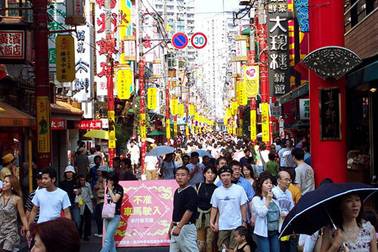China Abroad Part 1: The Liverpool Connection
Chinese people are possibly the world’s most visible race. As well as occupying one of the largest countries in the world, the Chinese presence across the globe is huge. Just think of any big city in the world, and the chances are that it will have a considerable Chinese population. My home town Liverpool has the oldest Chinatown in Europe, and London, where I lived for five years, also has a sizeable Chinese area. As for North America, Chinese culture is part of its very fabric, with long-established Chinatowns that are often as old as the cities they are part of, like San Francisco’s. Cantonese is the third most spoken language in the USA, after English and Spanish.

Photo: Rdesai
So how did Chinese people come to journey across the world and settle in so many places? What is the story of our home cities’ Chinatowns?
What we call Chinatown in English is tángrénjiē (唐人街) in Mandarin, and tongyangai in Cantonese, both meaning ‘street of the Tang people’. The Tang Dynasty was the period of China’s great cultural flourishing, and migrants were keen to ally themselves with this era. Sometimes, Chinatowns are known literally as zhōngguó chéng (中国城) or huábù (華埠). Some are, in fact, single streets, like Fisgard Street in Victoria, Canada, but most are neighbourhoods centred on a main avenue or area. They traditionally house restaurants, markets, schools, shops, and community centres, but are not always residential areas. High rent prices have pushed locals out in many city-centre Chinatowns.
The oldest Chinatowns in the world are in Asia, which makes geographical sense. Nagasaki, Yokohama, and Kobe became home to Chinese merchants who decided to settle in Japan, while Bangkok’s Yaowarat Road is where the first Chinese visitors to Thailand congregated. Chinese first began to venture outside of Asia when the Treaty of Peking made international travel possible in the 1860s. The first Chinatown to spring up outside of Asia was in Honolulu. In 1788, two ships called the Iphigenia and the Felice arrived in Hawaii from China to do trade, and left the following year. However, it wasn’t until 1852 that a Chinese population was established in Honolulu. That year, nearly 300 men were sent over by British racketeer John Cass to work on the sugar plantations for paltry salaries. Over the years, fire blighted Chinatown on several occasions, but it always regenerated, and by the early 1900s, 60% of all shops on Hawaii were Chinese-run, as were 85% of restaurants.
Unsurprisingly, it was Chinese people with coastal access who first began to migrate. Seeking their fortune in the New World, men from Guangdong, Hong Kong, and Fujian began to leave their homeland and head for the west. The Qing government didn’t care too much about this exodus. According to Confucianism, the pursuit of wealth was wrong, so the authorities branded the emigrants as disloyal to their country and thought no more of them.
Thousands of men from these coastal towns and cities made the journey to the Americas and Australia in search of wealth. Just as prospecting Westerners view today’s developing China as a pot of gold where business is concerned, so the 19th century Chinese saw potential in the West’s pioneering era.
But work was not always well-paid, and conditions were often bad. It was the Chinese who were saddled with the jobs no-one else wanted to do, such as working Cuba’s sugar farms or Peru’s guano fields, where stinking bird dung was harvested for fertilizer. Times were particularly hard for the Chinese immigrants to America’s West Coast. After toiling to complete the railways and coal mine networks, the Chinese were unceremoniously banned from the towns that they had helped build, thanks to the
But determination paid out, and eventually the Chinese were accepted into American society. San Francisco became a hub, attracting immigrants from Guangdong. Today, San Francisco’s Chinatown is one of the biggest in America, and certainly the oldest. Chinese Americans refer to it simply as dà chéng (大城) – ‘big town’.
In Europe, the story was slightly different. For a start, there was far more integration, and the Chinese arrived by different means. When trade routes were established with Liverpool and London, many Chinese seamen chose to settle in their destination ports, and had children with English women. Although never officially part of the British Empire, China held a sort of honorary place in the UK during imperial times, and the Navy often employed Chinese mariners to swell its ranks.
As for today, international Chinatowns are thriving, and are often the most colourful, diverse areas of the towns they inhabit. Go to any large city in the West and you’re sure to spot an unmistakeable red dragon-festooned arch – a sign of a nation that is very much on the world’s radar, both at home and abroad.
***
Related Articles:
China Abroad Part 1: The Liverpool Connection
Guangzhou to Increase Checks on Illegal Immigration
Is it Too Difficult for the Chinese to go Abroad?
Warning:The use of any news and articles published on eChinacities.com without written permission from eChinacities.com constitutes copyright infringement, and legal action can be taken.
All comments are subject to moderation by eChinacities.com staff. Because we wish to encourage healthy and productive dialogue we ask that all comments remain polite, free of profanity or name calling, and relevant to the original post and subsequent discussion. Comments will not be deleted because of the viewpoints they express, only if the mode of expression itself is inappropriate.
Please login to add a comment. Click here to login immediately.